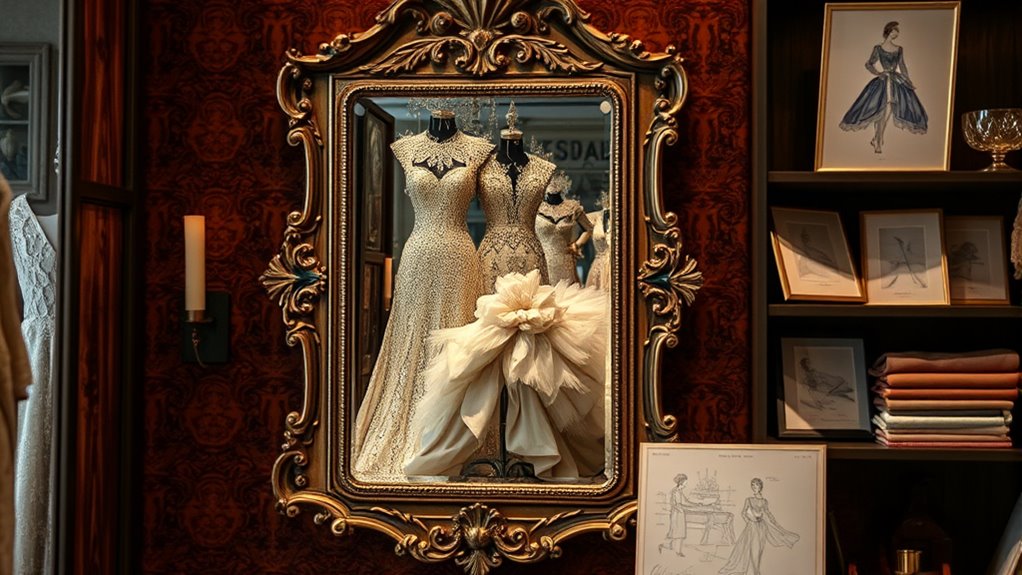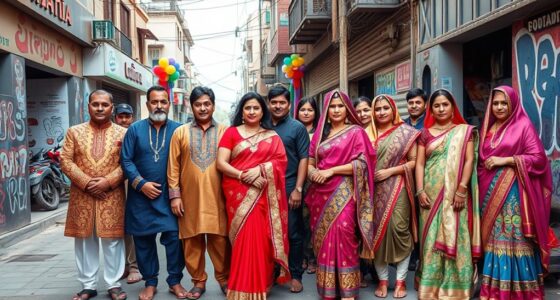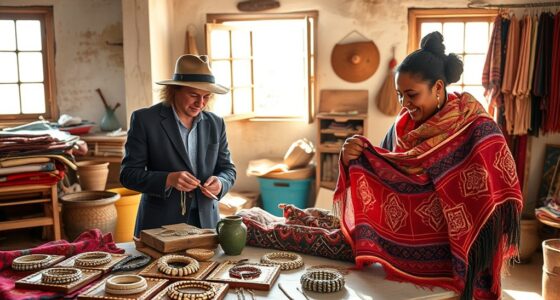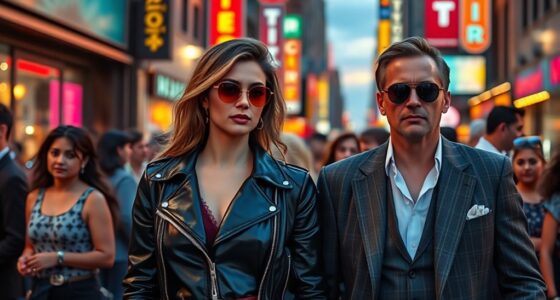Haute couture began in 19th-century France as custom-fitted garments for the wealthy, revolutionized by Charles Worth, who made fashion an art form. Over time, designers like Dior and Chanel transformed it into a cultural expression filled with innovation, style, and social impact. Today, technological advances and social movements shape its evolution, blending tradition with modernity. If you explore further, you’ll uncover how haute couture continues to influence art, society, and fashion’s future.
Key Takeaways
- Haute couture originated in 19th-century France, transforming tailored garments into bespoke art forms for elite clients.
- Post-WWII designers like Dior and Balenciaga redefined fashion as cultural and artistic expression with innovative silhouettes.
- Technological advances, including CAD and digital media, revolutionized design, manufacturing, and global dissemination of haute couture.
- Haute couture has historically influenced social and political movements, using fashion as a platform for cultural identity and societal change.
- Today, it blends tradition with innovation, emphasizing craftsmanship, sustainability, and digital integration to shape fashion as art and culture.
Origins and Early Developments in Haute Couture
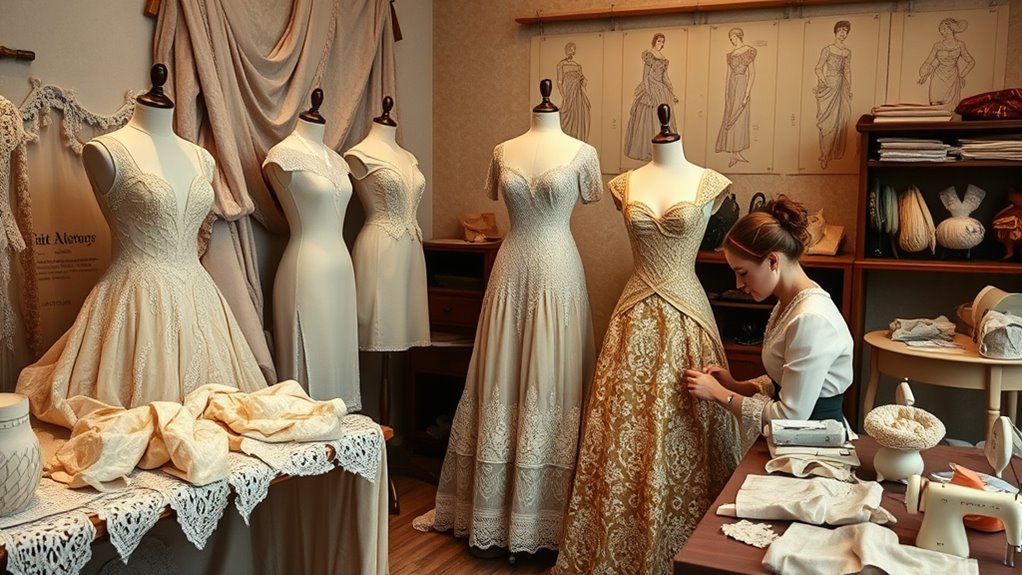
Haute couture’s origins trace back to 19th-century France, where innovative designers began creating custom-fitted garments for wealthy clients. You’d notice that designers like Charles Frederick Worth revolutionized fashion by sewing labels into their creations, making their names synonymous with luxury. These early pioneers focused on craftsmanship, using fine fabrics and elaborate handwork to craft one-of-a-kind pieces. As demand grew among Paris’s elite, fashion houses started to emerge, setting standards for personalized service and meticulous detail. You’d see that these developments laid the groundwork for haute couture’s reputation as the pinnacle of fashion artistry. It wasn’t just about clothing; it was about transforming fabric into works of art tailored specifically for each client’s body and style. Additionally, the emphasis on craftsmanship and innovation helped establish haute couture as a form of artistic expression in fashion. The role of survivability and technological advancements in fabric development further enhanced the ability to create intricate designs that pushed the boundaries of traditional fashion. Moreover, the integration of astrological compatibility and understanding of individual appeal played a subtle role in the personalized approach to haute couture.
The Golden Age of Fashion: 20th Century Innovations
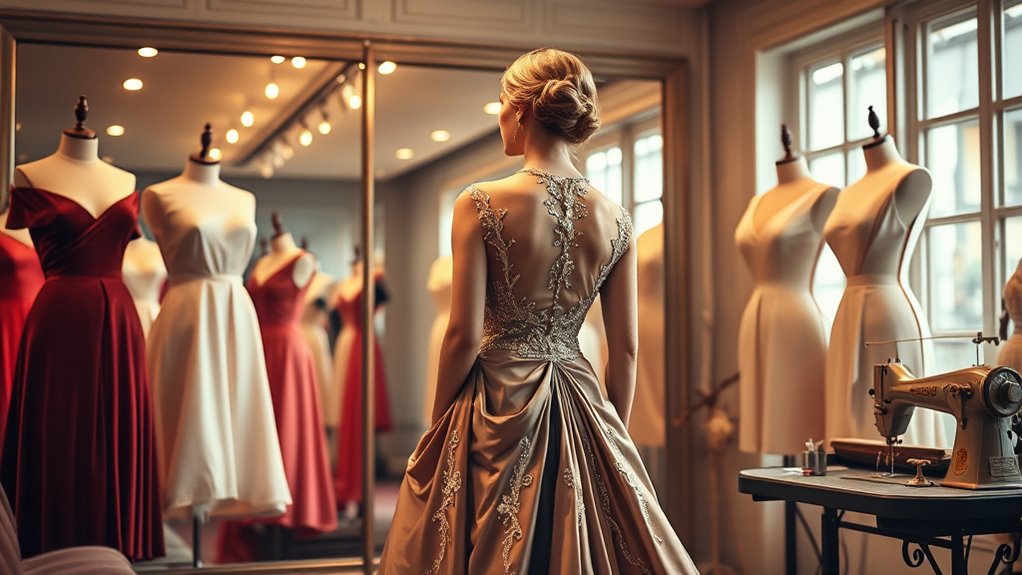
After World War II, fashion experts experienced a surge of creativity that redefined style. Iconic designers like Dior and Balenciaga pushed boundaries with bold new ideas, inspiring countless imitators. Advances in technology also transformed how garments were made, allowing for innovative fabrics and construction methods. Furthermore, the rise of retail store hours and increasing accessibility to various brands helped democratize fashion, making haute couture more widely appreciated. This era also saw the emergence of diverse designs and more playful, experimental approaches to fashion design. Additionally, the development of textile innovation played a crucial role in expanding the possibilities for designers during this period. Embracing the beauty of rustic aesthetics contributed to the creative evolution of haute couture, blending traditional craftsmanship with modern innovations. The influence of global cultures also became more prominent, enriching the cultural diversity seen in fashion collections of the time.
Post-War Creativity Surge
Following the devastation of World War II, designers experienced a surge of creativity that transformed fashion into a symbol of hope and renewal. You see, with materials scarce and wartime restrictions easing, designers experimented boldly, pushing boundaries to reinvent style. They embraced new fabrics, innovative cuts, and daring silhouettes, reflecting optimism for the future. This era marked a shift from utilitarian clothing toward expressive, artistic designs that celebrated individuality. You notice the emergence of luxurious yet practical fashion, blending craftsmanship with modern ideas. Fashion houses reopened with renewed vigor, and couture became a statement of resilience. This surge cultivated a sense of freedom and optimism, fueling the post-war cultural rebirth and setting the stage for fashion’s golden age. Additionally, the adoption of innovative fabrics allowed designers to explore new textures and finishes, further elevating the artistic quality of haute couture. Furthermore, advancements in fabric technology enabled the creation of more diverse and comfortable garments, expanding the possibilities for creative expression in fashion. Interestingly, the integration of new textile techniques played a crucial role in elevating couture to a true art form, inspiring designers to push creative boundaries even further.
Iconic Designer Pioneers
The post-war creative boom gave rise to a new wave of visionary designers who redefined fashion’s possibilities. You might recognize names like Christian Dior, whose “New Look” revolutionized silhouettes with its feminine curves and elegance. Coco Chanel broke conventions by simplifying designs and introducing comfortable, stylish pieces that liberated women from restrictive clothing. Yves Saint Laurent pushed boundaries with his innovative tuxedo suits for women, blending masculinity and femininity. Hubert de Givenchy combined artistry and refinement, dressing icons like Audrey Hepburn. These pioneers didn’t just create clothing—they transformed fashion into a form of artistic expression and cultural identity. Their bold visions laid the foundation for modern haute couture, inspiring future generations to see fashion as a dynamic, creative force. Additionally, the rise of Glycolic Acid in skincare highlights how innovation continues to shape the evolution of beauty and aesthetics, emphasizing the importance of technological advancements in the industry. The innovations introduced during this era also set the stage for the integration of art and culture into fashion, further elevating it beyond mere clothing. Furthermore, the influence of spiritual symbolism can be seen in some designers’ use of motifs and themes that reflect deeper cultural narratives, enriching the artistic dimension of haute couture. This era also marked a shift toward embracing diverse cultural influences, broadening the scope of inspiration for future designers.
Technological Fashion Advances
During the 20th century, technological innovations dramatically transformed the way fashion was designed, produced, and experienced. You witness the rise of sewing machines, which sped up manufacturing and allowed for mass production. Fabrics became more diverse with synthetic materials like polyester and nylon, expanding design possibilities. You see designers experimenting with new techniques, such as computer-aided design (CAD), which enhanced precision and creativity. Fashion shows also evolved, incorporating television and later digital media, making runway collections accessible worldwide. Innovations in textile technology improved durability and comfort, changing consumer expectations. You now experience a shift from handcrafted couture to industrialized processes, making fashion more accessible, while still celebrating artistry. These advances fundamentally shape fashion as both a cultural expression and a commercial industry. Additionally, the development of fashion technology has opened new avenues for innovation, influencing current and future design practices.
Pioneers Who Changed the Fashion Landscape

Innovative designers have consistently reshaped the fashion landscape by challenging conventions and introducing new ideas. You see their influence in bold silhouettes, revolutionary techniques, and boundary-pushing aesthetics that redefine style norms. These pioneers include visionaries who transformed fashion from mere clothing into art forms with cultural impact. They broke rules, experimented with materials, and created iconic collections that still inspire today. Their contributions made the industry more dynamic, diverse, and innovative. For example, the development of Textile Line techniques has enabled designers to push creative boundaries further than ever before, fostering a multifaceted approach to fashion design. Additionally, the integration of innovative materials has allowed for more expressive and avant-garde creations that continue to shape haute couture. This evolution is also influenced by technological advancements, which have opened new avenues for experimentation and artistic expression in fashion.
Haute Couture’s Role in Cultural and Social Movements
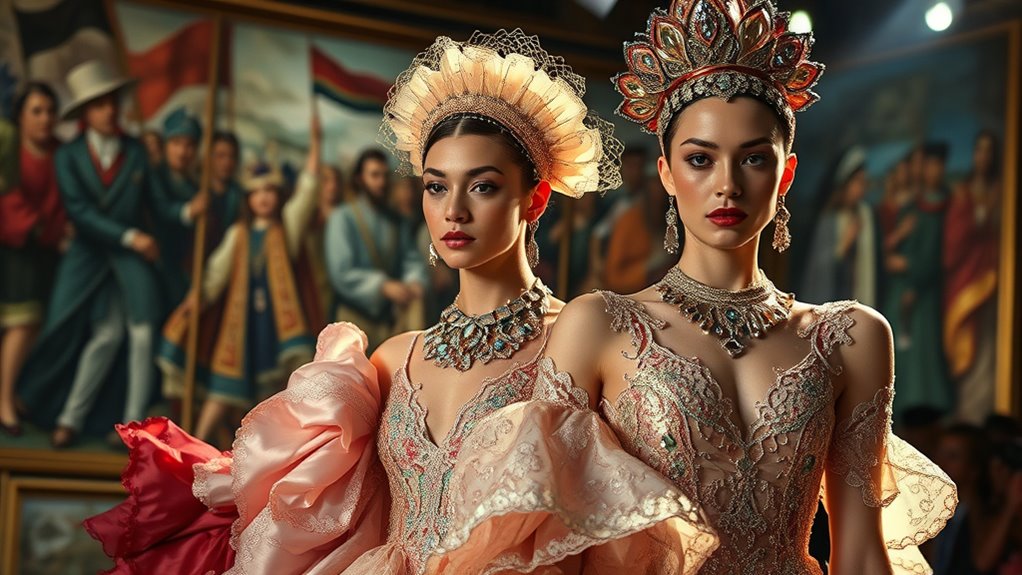
Haute couture has long served as a powerful platform for expressing and shaping cultural and social movements. Designers have used their creations to challenge norms, promote equality, and highlight political issues. For example, during the 1960s, fashion became a statement of rebellion and freedom, with bold designs reflecting social upheaval. Similarly, in recent years, couture has supported movements like gender fluidity and environmental sustainability. The table below shows how haute couture intersected with key movements:
| Movement | Designer/Example | Impact |
|---|---|---|
| Civil Rights | Black designers, using fashion to empower | Promoted representation and inclusion |
| Feminism | Feminist slogans on gowns | Challenged gender stereotypes |
| LGBTQ+ | Gender-neutral designs | Advocated for acceptance |
| Environmental | Sustainable couture collections | Raised awareness about eco-issues |
| Political Protests | Wearable statements, activism | Sparked conversations on social justice |
Additionally, couture has become a symbol of cultural identity, reflecting and influencing societal values. Its ability to communicate complex messages through innovative designs continues to influence societal change, and inspire new generations of designers and activists alike. Furthermore, the integration of technological advancements in couture has expanded its role as a medium for cultural expression, pushing the boundaries of traditional fashion. Incorporating new materials and digital techniques has further enhanced its capacity to serve as a vehicle for social commentary.
Modern Evolution and the Digital Age of Fashion

The digital age has revolutionized the way fashion is created, shared, and consumed, transforming haute couture from exclusive ateliers into a global phenomenon accessible to a wider audience. You now witness designers leveraging social media, virtual showrooms, and 3D printing to innovate and reach consumers instantly. This shift democratizes fashion, making high-end designs more visible and interactive. You can explore runway shows from anywhere, participate in virtual fitting rooms, and even customize pieces digitally. The speed of trends accelerates, and collaborations across borders become seamless. To deepen your understanding, consider how:
- Social media platforms amplify designer visibility
- Virtual fashion shows challenge traditional runway models
- 3D printing enables sustainable, custom creations
- Influencers influence high fashion trends
- Digital archives preserve haute couture history
- Supermarket hours can impact the timing of fashion-related events and shopping habits
Additionally, the integration of digital technology has facilitated global collaboration among designers, fostering innovation and cross-cultural exchanges in fashion development.
Haute Couture’s Legacy and Future Directions
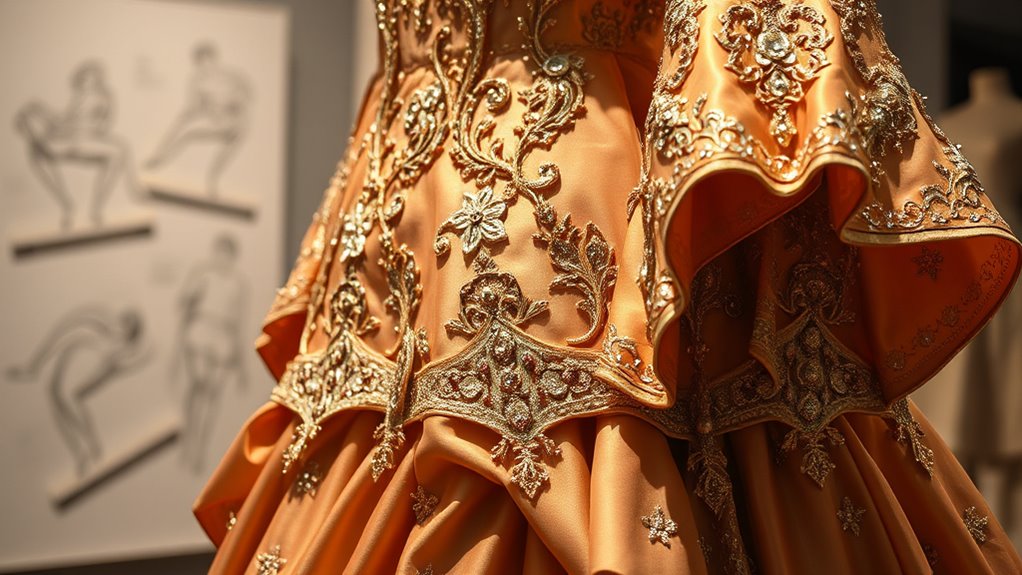
As we look ahead, haute couture continues to shape fashion’s future by balancing its rich legacy with innovative approaches. Your appreciation for craftsmanship fuels the ongoing relevance of handcrafted details and bespoke tailoring. Designers are blending tradition with technology, integrating sustainable practices and digital tools like 3D printing to push creative boundaries. The legacy of haute couture as art remains essential, inspiring emerging talents and redefining luxury. Future directions involve making couture more inclusive and accessible while maintaining exclusivity. You’ll see more collaborations across disciplines, merging fashion with art, technology, and culture. Haute couture’s enduring influence ensures it remains a symbol of innovation, individuality, and craftsmanship—continuing to inspire and challenge the fashion world for generations to come.
Frequently Asked Questions
How Does Haute Couture Influence Mainstream Fashion Trends Today?
You see, haute couture influences mainstream fashion by setting innovative trends that trickle down into everyday styles. Designers often showcase daring, artistic pieces on the runway, inspiring mass-market brands to adapt these ideas for broader audiences. When you notice bold fabrics, unique silhouettes, or luxurious details in stores, it’s often a reflection of haute couture’s creative vision, shaping what becomes fashionable for everyone.
What Are the Economic Impacts of Haute Couture on Global Markets?
Did you know that the global luxury fashion market, driven by haute couture, reached over $300 billion in 2023? You see, haute couture impacts the economy by setting high standards for craftsmanship, which boosts related industries like textiles and jewelry. It also attracts wealthy clients worldwide, fueling international trade. So, its influence extends beyond style, shaping global markets and creating jobs, making it an essential economic force.
How Do Cultural Differences Shape Haute Couture Designs Worldwide?
You see that cultural differences greatly influence haute couture designs worldwide. When designers draw inspiration from local traditions, textiles, and aesthetics, they create unique, culturally rich pieces. Your awareness of these influences helps you appreciate the diversity in haute couture, as each piece reflects its origins. By respecting and incorporating different cultural elements, you contribute to a more inclusive and innovative fashion industry that celebrates global heritage.
What Ethical Considerations Are Involved in Haute Couture Production?
When you think about haute couture production, you need to take into account ethical issues like fair labor practices, sustainable sourcing, and animal welfare. You should make certain that materials are responsibly sourced and workers are paid fairly and work in safe conditions. By prioritizing transparency and environmental impact, you can support ethical standards in fashion, helping to promote a more responsible and conscious industry.
How Is Sustainability Integrated Into Modern Haute Couture Practices?
You see, sustainability in modern haute couture involves designers and brands actively choosing eco-friendly materials, such as organic fabrics and recycled textiles. They also minimize waste through precise pattern making and innovative techniques. Many incorporate ethical practices, like fair labor standards, and aim to reduce carbon footprints by using local sourcing and sustainable production methods. This way, you can enjoy high-fashion pieces that align with environmental and ethical values.
Conclusion
As you explore haute couture’s journey, you realize it’s a vibrant tapestry woven with innovation, rebellion, and artistry. Like a phoenix rising from the ashes of tradition, it continually transforms, shaping culture and inspiring generations. Its legacy is a demonstration to fashion’s power to reflect society’s soul, proving that in the world of haute couture, creativity is the unbreakable thread connecting past, present, and future. Embrace its story, and see fashion as your own canvas of expression.
